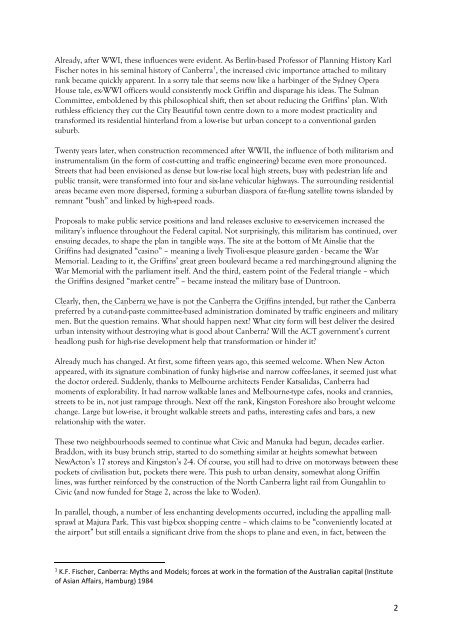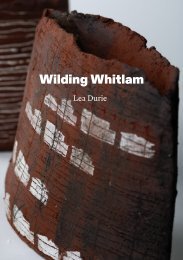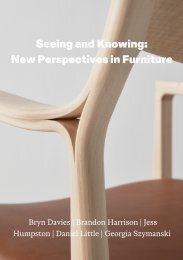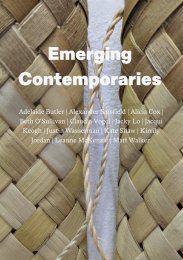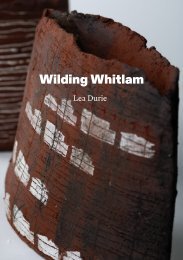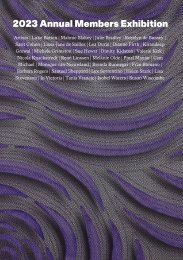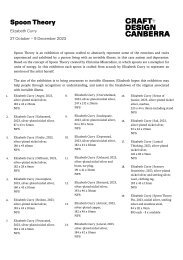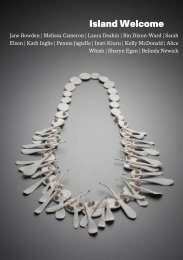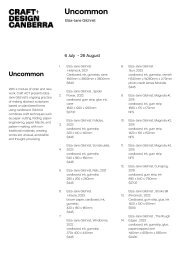TRANSFORMING CANBERRA
An Essay By Elizabeth Farrelly
An Essay By Elizabeth Farrelly
Create successful ePaper yourself
Turn your PDF publications into a flip-book with our unique Google optimized e-Paper software.
Already, after WWI, these influences were evident. As Berlin-based Professor of Planning History Karl<br />
Fischer notes in his seminal history of Canberra 1 , the increased civic importance attached to military<br />
rank became quickly apparent. In a sorry tale that seems now like a harbinger of the Sydney Opera<br />
House tale, ex-WWI officers would consistently mock Griffin and disparage his ideas. The Sulman<br />
Committee, emboldened by this philosophical shift, then set about reducing the Griffins’ plan. With<br />
ruthless efficiency they cut the City Beautiful town centre down to a more modest practicality and<br />
transformed its residential hinterland from a low-rise but urban concept to a conventional garden<br />
suburb.<br />
Twenty years later, when construction recommenced after WWII, the influence of both militarism and<br />
instrumentalism (in the form of cost-cutting and traffic engineering) became even more pronounced.<br />
Streets that had been envisioned as dense but low-rise local high streets, busy with pedestrian life and<br />
public transit, were transformed into four and six-lane vehicular highways. The surrounding residential<br />
areas became even more dispersed, forming a suburban diaspora of far-flung satellite towns islanded by<br />
remnant “bush” and linked by high-speed roads.<br />
Proposals to make public service positions and land releases exclusive to ex-servicemen increased the<br />
military’s influence throughout the Federal capital. Not surprisingly, this militarism has continued, over<br />
ensuing decades, to shape the plan in tangible ways. The site at the bottom of Mt Ainslie that the<br />
Griffins had designated “casino” – meaning a lively Tivoli-esque pleasure garden - became the War<br />
Memorial. Leading to it, the Griffins’ great green boulevard became a red marching-ground aligning the<br />
War Memorial with the parliament itself. And the third, eastern point of the Federal triangle – which<br />
the Griffins designed “market centre” – became instead the military base of Duntroon.<br />
Clearly, then, the Canberra we have is not the Canberra the Griffins intended, but rather the Canberra<br />
preferred by a cut-and-paste committee-based administration dominated by traffic engineers and military<br />
men. But the question remains. What should happen next? What city form will best deliver the desired<br />
urban intensity without destroying what is good about Canberra? Will the ACT government’s current<br />
headlong push for high-rise development help that transformation or hinder it?<br />
Already much has changed. At first, some fifteen years ago, this seemed welcome. When New Acton<br />
appeared, with its signature combination of funky high-rise and narrow coffee-lanes, it seemed just what<br />
the doctor ordered. Suddenly, thanks to Melbourne architects Fender Katsalidas, Canberra had<br />
moments of explorability. It had narrow walkable lanes and Melbourne-type cafes, nooks and crannies,<br />
streets to be in, not just rampage through. Next off the rank, Kingston Foreshore also brought welcome<br />
change. Large but low-rise, it brought walkable streets and paths, interesting cafes and bars, a new<br />
relationship with the water.<br />
These two neighbourhoods seemed to continue what Civic and Manuka had begun, decades earlier.<br />
Braddon, with its busy brunch strip, started to do something similar at heights somewhat between<br />
NewActon’s 17 storeys and Kingston’s 2-4. Of course, you still had to drive on motorways between these<br />
pockets of civilisation but, pockets there were. This push to urban density, somewhat along Griffin<br />
lines, was further reinforced by the construction of the North Canberra light rail from Gungahlin to<br />
Civic (and now funded for Stage 2, across the lake to Woden).<br />
In parallel, though, a number of less enchanting developments occurred, including the appalling mallsprawl<br />
at Majura Park. This vast big-box shopping centre – which claims to be “conveniently located at<br />
the airport” but still entails a significant drive from the shops to plane and even, in fact, between the<br />
1<br />
K.F. Fischer, Canberra: Myths and Models; forces at work in the formation of the Australian capital (Institute<br />
of Asian Affairs, Hamburg) 1984<br />
2


